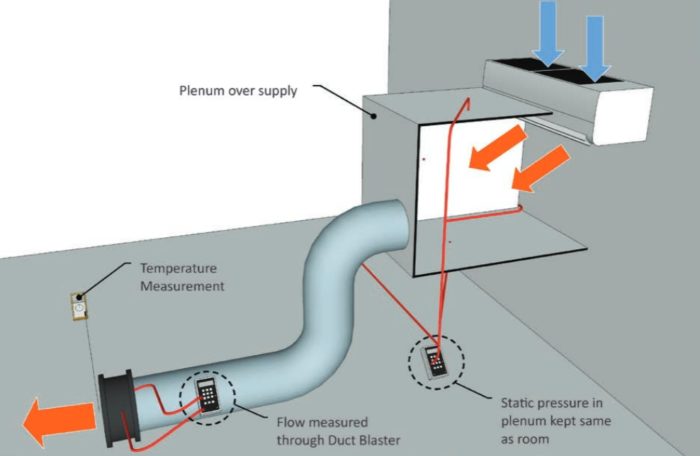
Image Credit: Photo of dog on floor: Peter Talmage; all other images: Consortium of Advanced Residential Buildings
A recent monitoring study of ductless minisplits installed in seven New England homes found that these heating appliances had lower airflow rates and lower coefficients of performance (COPs) than expected. The average COP of these air-source heat pumps ranged from 1.1 at the house with the least-efficient minisplit to 2.3 at the house with the most-efficient minisplit.
The results of the study raise at least as many questions as they answer. Perhaps the most useful outcome of the study is that it sets up a framework for recommendations that could enhance minisplit efficiency.
The research was conducted by James Williamson and Robb Aldrich from the Consortium of Advanced Residential Buildings (CARB) in Norwalk, Connecticut. The study was funded by the U.S. Department of Energy’s Building America program. The researchers’ report, “Field Performance of Inverter-Driven Heat Pumps in Cold Climates,” was published in August 2015.
Monitoring Mitsubishi and Fujitsu units in seven homes
The researchers were aiming to fill in gaps in our knowledge of minisplit performance in cold climates. They wrote, “There are still uncertainties … about capacity and efficiency in cold weather. Also, questions such as ‘how cold is too cold?’ do not have clear answers.”
Williamson and Aldrich collected useful data from seven houses during the winter of 2013-2014. (At three other houses, problems with the monitoring equipment interfered with data collection, so these houses were excluded from the study.) The houses were located in Connecticut, Massachusetts, and Vermont.
The researchers wrote, “Operating data were collected for three Mitsubishi FE18 units, three Mitsubishi FE12 units, and one Fujitsu 15RLS2 unit. The intent of this research was to assess heat output, electricity consumption, and coefficients of performance (COPs) at various temperatures and load conditions. This assessment was accomplished with long- and short-term…
Weekly Newsletter
Get building science and energy efficiency advice, plus special offers, in your inbox.

This article is only available to GBA Prime Members
Sign up for a free trial and get instant access to this article as well as GBA’s complete library of premium articles and construction details.
Start Free TrialAlready a member? Log in





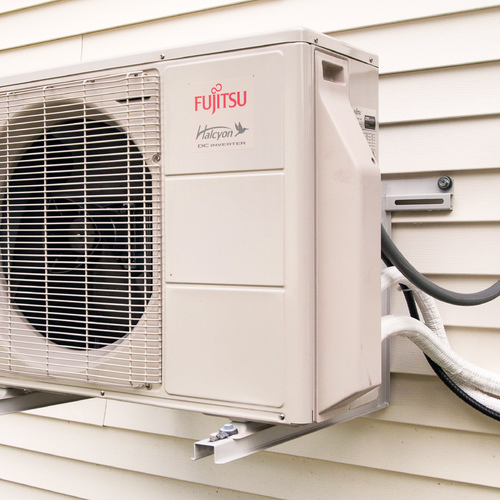
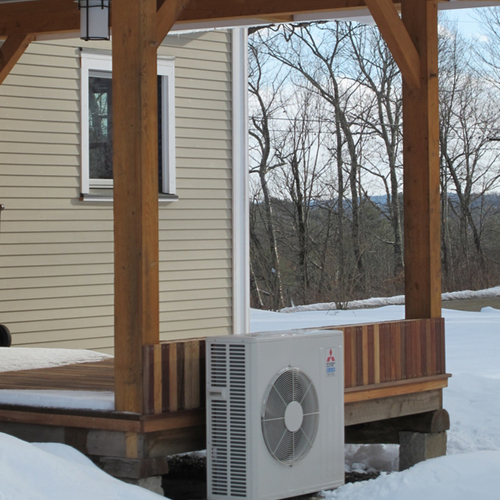
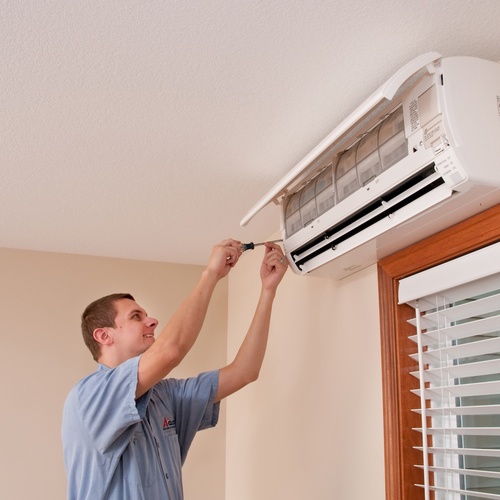
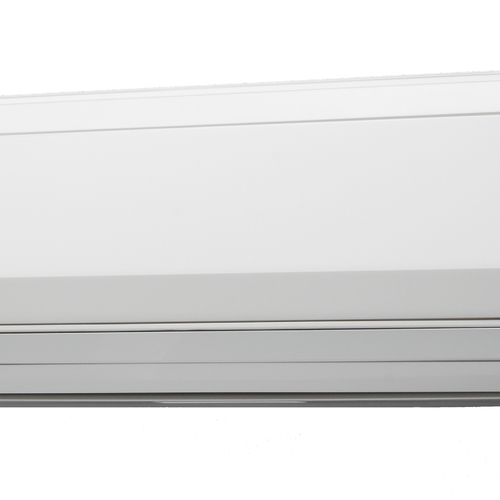






20 Comments
return temperature
Very interesting results. Thanks for the excellent summary.
The return temperature is a key factor that I for one had not previously given enough attention. It might even be worse in practice than in the measurements, since the added plenum separates supply and return somewhat and should help. From a comfort perspective, having the room where the head is located warmer than others is not a bad thing. Like the happy dog in the picture, people can migrate to the warm room if they are feeling chilly, and vice versa if they are feeling warm. But these results show that the warm room also degrades COP, and can e bad for performance even it it is fine for comfort.
Ducted minisplits might be another way to improve the return temperature.
The performance is still impressive, even if it's lower than other studies indicate.
Ground source heat pumps had been seeming hard to justify in comparison with minisplits, but with minisplit performance looking worse than we thought, and with similar technology (such as variable speed compressors) starting to be available in ground-source heat pumps, maybe ground source heat pumps will become more interesting again. Unfortunately, the high-performance technology seems to be available only in large ground-source heat pumps right now.
If residential customers start getting charged for peak electrical demand like commercial customers do, the characteristic of air source heat pumps, that they are least efficient at times of peak demand, will start to matter more, and that will also push us back towards ground-source heat pumps. There's a long way to go in making ground-source heat pump systems cost effective and easy to get working right, but it should be possible to improve that situation.
There's a lot to getting the sizing right, and it matters.
It's easy to jump to the wrong conclusions if looking only at a summary. Almost all of these units were way undersized for the loads, and rarely modulating. At least one (site 2) was severely OVERsized for the load, spending most of the season cycling.
None were optimally sized to be able to modulate most of the season. Most of sites monitored were in US climate zone 6A, and installed with the intent of offsetting oil use. Almost everyone using mini-splits to offset expensive fossil use sets the thermostat of the fossil burner to only kick on when the mini-split can't keep up. None of the house descriptions were likely to have more than about 1/4 of their design load covered by the mini-split, which makes them very undersized for the heating loads. It's remarkable that even when running at poorest efficiency due to undersizing it was still cheaper than the oil/propane heat it was offsetting. When used in this manner it's not surprising to see seasonal averages in the 2s or lower in a zone 6 climate.
Undersizing is usually worse than oversizing, since that leads to running at max speed and lowest efficiency during even moderately cold weather when COPS would be already be slipping, and guarantees worst performance as temps fall. You don't get the part-load modulating efficiency unless it's actually modulating, and that goes for both ends. Running balls-to-the-walls efficiency is going to suffer, and cycling on/off it's going to suffer. Sizing mini-splits optimally, where the design load is covered, but the minimum-modulation is low enough avoid on/off cycling has almost become my mantra. Not all mini-splits have the same range, and not all houses have the same loads.
It's a bit harder to size mini-splits optimally in a zone 6 climate than in zone 5, but it can be done. Where applicable I'm a big fan of the Mitsubishi FH09NA, due to it's whopping 11:1 turn-down ratio, which gives it a maximal modulatioin range.
At site-2, the PassiveHouse in Danbury CT (climate zone 5, outside design temp of about +5F) the design heat load was only 6000 BTU/hr, which makes the FE12's 13,600 max capacity @ +5F more than 2x oversized for the load on design day, but it also means that it's min-modulated output of 3000 BTU/hr @ 47F will have it cycling on/off most of the season. The heating/cooling balance point is probably in the 50-55F range, and it won't see a heat load of 3000 BTU/.hr until it's below freezing. Whenever it's above freezing it'll be cycling, and that's MOST of the heating season in Danbury! The FE09 would not have done any better, since it's min-modulation is also 3000 BTU/hr, but the new FH09NA would do pretty well in that house, with it's 1600 BTU/hr @ 47F minimum.
Of the units in the study, the FE18 is perhaps the most difficult of the bunch to match to the load, since it has only a 3:1 turn down ratio, compared to 4.5:1 for the FE12, and 6:1 for the 15RLS2.
Also note, these are all more than 5 years old, and lower efficiency than current models. The tested HSPF of the Mitsubishi FE12 and FE18 (which comprise all but one of the units tested) is only 10.3-10.5, well behind the current equivalents which test the 12s. The lone Fujitsu 15RLS2 tested at HPSF 12.0, compared to the current version's 13.4.
The Mitsubishi 1-tonners
old, HPSF 10.6: http://usa.mylinkdrive.com/uploads/documents/1642/document/MSZ-FE12NA-MUZ-FE12NA_Submittal.pdf
new HSPF 12.5: http://usa.mylinkdrive.com/uploads/documents/4561/document/MSZ-FH12NA_MUZ-FH12NA_Submittal.pdf
The 1.5 tonners:
old, HSPF 10.3: http://usa.mylinkdrive.com/uploads/documents/1643/document/MSZ-FE18NA_MUZ-FE18NA_Submittal.pdf
new, HSPF 12.0: http://usa.mylinkdrive.com/uploads/documents/5083/document/MSZ-FH18NA_MUZ-FH18NA_Submittal.pdf
The Fujitsu 1.25 tonners:
Old, HSPF 12.0: http://www.fujitsugeneral.com/PDF_06/Submittals/15RLS2%20Submittal.pdf
New, HSPF: 13.4: http://www.fujitsugeneral.com/PDF_06/Submittals/15RLS3HSubmittal.pdf
So, while new installations can expect to be 10-15% higher efficiency in a straight swap-out, an optimally sized older unit could still beat a badly under / oversized newer version that doesn't modulate.
Response to Dana Dorsett
Dana,
This study raises a lot of questions, as I wrote, and there are no clear take-aways. I appreciate your comments about right sizing.
In general, the residential HVAC industry in the U.S. does a terrible job of sizing heating and cooling equipment. Few contractors are able to perform an accurate Manual J heating and cooling load calculation -- an essential first step to right sizing -- and existing building code provisions that require Manual J calculations are largely unenforced. This problem needs to be addressed by the HVAC industry and code officials.
So this isn't just a ductless minisplit issue. It's also an issue for conventional furnaces and split-system air conditioners.
That said, most ductless minisplits that are being installed in homes are not right-sized. On a green building site like this one, we can rail against sizing problems all we want. But if, in the real world, 90% of ductless minisplits are seriously undersized or oversized, we have to ask ourselves if this is an inherent problem with the technology that we need to address -- one that deserves new solutions and new approaches -- or if this is just one more example of American stupidity.
If we just roll our eyes and say, "American stupidity again," we may not be providing good advice to concerned homeowners and builders. We need to provide solutions that work in the real world -- robust solutions that are easy to implement.
If most installations are wrong, we may need to start with a fresh sheet of paper and re-think our approach.
James Williamson and Robb Aldrich measured the performance of real, installed systems. Their data are useful. If the average COPs of these installed systems are low, we need to know that fact. If ideal systems (right-sized systems that are perfectly installed) are rare, then we can't pretend that the ideal system -- the type of system recommended on GBA -- is typical.
What do we know?
Perhaps the most important result in this report is that the monitoring results that used rated rather than measured flow should be discounted. Then we can take inventory of what we know. We have these results of real application sub-optimal sizing performance with 2ish COP, and we have the one co-heating experiment with COP 2.7. I am inclined to believe that the 2.7 result is a reasonable estimate of performance with a well sized well installed system in a cold climate. It would be very useful to have more measured in situ results, and comparisons between those and modelled performance, but until then it seems reasonable to say you can get COP 2 without really trying, 2.7 in zone 6 if you do it right, and likely more than 3 in zone 5. That summary is superficial for sure, but it is a better representation than some of what we have been saying.
For replacing or supplementing straight electric heat, it is still a great opportunity. For replacing cheap fossil fuels, the economic case is not as clear. It would be nice if you could set a lower bound on COP and have the unit automatically shut off and call on the combustion source if the COP got below that threshold.
Mount low on wall is a recommendation? What?
Mounting low on the wall for lower return air temps increase efficiency in winter, but what about AC in summer?
In cold-weather climate zones this may seem appropriate, but what happens when you proceed south into zones that require equal time for AC?
Why is all research done in Zone 6!?! Why is it then reported as applying equally to all?
Response to David McNeely
David,
Thanks for your comments. As my article clearly states, the research was conducted in Connecticut, Massachusetts, and Vermont. I doubt whether anyone reading the article missed the geographic reference.
I assume that GBA readers understand that air conditioning systems are often designed to deliver cool air near ceilings, and the heating systems are often designed to deliver warm air near floors. You are quite right that Florida residents who install ductless minisplits will doubtless continue to mount their indoor units high up on their walls, as they always have.
I have edited the relevant bullet point in my list of recommendations to clear up any ambiguities. Again, thanks for your comments.
re
Airflow is a tricky thing, to pretend that airflow in a box is the same as in a room is somewhat non scientific.
That said, my own limited experiments made me believe that my minisplits were not efficient enough to replace my 90 percent boiler, where I had anticipated a fraction of cost, it was a wash in a one month shoulder season trial, so I will not be not completely surprised if the results hold up
Response to Keith Gustafson
Keith,
The recommendation to install the indoor unit of a ductless minisplit system near the floor has to do with lowering the return-air temperature, not making sure that the delivered air is properly mixed. In general, minisplit manufacturers have done a good job of designing these units to throw the air well, and to mix it with the room air, to minimize comfort complaints.
That said, some of the findings of Williamson and Aldrich are surprising -- especially the findings that (a) measured airflow rates are lower than manufacturers' specs, and that (b) adjusting the louvers the wrong way can make a bad situation even worse. I suspect that future research will reveal that the situation is not quite as simple as this summary sounds -- so I look forward to future research results.
positive data
As far as I can tell I'm getting a pretty solid 3.0 COP out of a
ducted air-source system, and likely better than that after I set
it to "reduced demand" which is its only option for modulating
down from full-out operation. Although it self-modulates in cooling
mode it does simply cycle in heating mode, which I found surprising but
can sort of see the reasoning behind for such a system. All systems
will effectively "cycle" when they start a defrost operation anyway,
so those need to be considered as well. Bringing my system down
to just over 1 ton capacity runs a lower compressor speed and line
current, and is actually a more exact match for the house at design
temps anyway.
The 3-kilowatt "toaster" got mounted back into the air handler for this
coming winter, and I'll be doing another season alternating periods of
heat-pump operation vs. pure resistance electric heating over the
winter. Accounting for all energy coming into the house and all major
paths of heat gain and loss, and matching to degree-days and even
keeping track of clear vs. cloudy, will hopefully yield far more
accurate COP measurements than I've gotten to date. It's sort of
the expensive way to go at it, but this is for community geek value.
_H*
Response to Hobbit
Hobbit,
Thanks for your comments. We always welcome data from readers.
Response to Bob Manninen
Bob,
First of all, your definition of COP is backwards. COP is Output / Input, not Input / Output. [P.S. -- I see that you have edited your comment to bring it in alignment with the usual definition.]
Second, I'm not sure that I understand your basic point. I agree that we aim for occupants to be comfortable. Are you implying that occupants of homes heated with ductless minisplits are comfortable at lower indoor air temperatures than occupants of homes heated with other types of equipment?
Assuming that our goal is (for example) to maintain a house within a defined temperature range -- perhaps 68 to 72 degrees -- and we want to understand what type of equipment is most efficient at creating those conditions, we would compare (for example) the energy it takes for an electric-resistance heater to achieve those conditions with the energy it takes for a ductless minisplit to achieve those conditions.
If we know the COP of the minisplit, we know how much electricity (in kWh) the appliance uses to produce a certain amount of heat (which can also be expressed in kWh). When it comes to electric resistance heat, the COP is 1.0, so that is the number to beat.
sleep and temperature
Coincidentally, I recently saw a science news story about a study that suggests that a drop in temperature helps people sleep well: According to http://news.sciencemag.org/biology/2015/10/chances-are-you-re-getting-enough-sleep
"The team also learned that cool temperatures may be as important as fluctuations in light to regulate sleep, since these people went to bed well after dark and awoke before sunrise. “While light is important, temperature may be more important from an evolutionary point of view,” says Siegel. This suggests that one bit of common wisdom may be right: To get better sleep, turn down the thermostat or open the window at night."
Are we going to need to start having R40 walls and passivhaus-rated doors between our living rooms and bedrooms so that the warm living rooms don't overheat the bedrooms?
Bob's question
I've also wondered about setback costs and savings. I think Bob is asking if you set back the thermostat for eight hours because you prefer it cooler at night, do you really lose the whole nights savings when it reheats in the morning?
Response to Andy Kahn
Andy,
The answer to your question depends on what type of heating equipment you're talking about.
With electric resistance heating, a thermostat setback will certainly save energy.
However, every researcher who has looked into the question has concluded that a thermostat setback with a ductless minisplit doesn't save any energy -- and in fact setbacks often result in higher energy bills. A ductless minisplit is most efficient when it is running continuously with a constant load. (Needless to say, ideally the heating load is well matched to the capacity of the unit.)
Of the people & know personally who heat with mini-splits...
Of the people & know personally who heat with mini-splits none put a mini-split head in the bedroom, and either open or close the door to regulate the temperature in that room. That usually means leaving the door open during the day, and closing it at night.
While this does impart changes in load for the mini-split, the changes in load are pretty slow & subtle, and do not result in on/off cycling or having to run at maximum-speed/lowest-efficiency the way it would on recovery ramps from deep setback, assuming it's sized reasonably for the whole-house or whole zone load.
One of my relatives will backstop the temp in the master bedroom with resistance heating under thermostat control on the coldest nights of the year if the door is going to be closed for privacy.
Thoughts
Energy IN is fairly easily logged, however energy OUT is the tough one : BTU/hr = Airflow (CFM) * Temperature Difference (dT) * (specific heat*specific density*60min/hr) - if CFM in field is lower than published we will certainly see lower field vs published COP. I hope to see future reports that will be able to further identify airflow performance. I would be curious if other methods such traversing the RA grille of ASHP with a wand (typ done in commercial air balancing for grilles) to log avg velocity over given free area may result in a closer to published readings – not relying on a fab’ed xps box and ductblaster. Nice to see people out there trying to capturing this data. Thanks for the report and summery.
Also, were line lengths recorded and if any ref was added based on line length
Is COP really the correct metric?
Silly question/comment. Is the "COP" metric really what we want to use as the defining measure of efficiency? COP, I believe, is defined as: Power Output/Power Input. But for heating purposes, (I don't wish to talk about cooling for this question) would another measure, which I imagine is much harder to obtain, be how much energy is used to maintain a "useful/comfortable" temperature? I realize that the mini-split UNIT efficiency suffers when it's called on to make up for a setback, but if the occupants are comfortable during the setback (I know I like to to be cooler when I'm sleeping, for instance) and the unit efficiency suffers during the temperature recovery, is the total number of watts consumed by the unit less than if the unit is allowed to modulate at a constant temperature? It's somewhat analogous to driving a car that gets 20 mpg on the highway and 15 mpg city driving; if it's 20 miles to get somewhere on the highway vs taking the back road route that is 7 miles shorter; you used less gas taking the shorter route, even if it takes longer (i.e., stop lights, etc.).
Given all of that, I guess the only way to come up with a viable measure is by using the two house experiments, where one is set up using electric resistance heat and the other using the mini-split. Although it would be interesting to see what the usages are with and without setback strategies.
any evolution in on-off efficiency?
I've seen the various reports on how the ductless minisplits perform better without cycling on and off. One issue in all the reports is that they are usually a model or two behind the latest releases. Are the companies really not making any progress on that? For instance, in the latest Fujitsu manuals for the single head units there are whole sections on how it can be set to ramp up slowly in a stepwise fashion to any temperature changes instead of one big blast, and 'economy modes' in which it won't power on hard enough to overshoot a temperature setting but rather approach it asymptotically. Has that kind of behavior been standard for a long time, or is it possible that the ability to respond to changing set-points efficiently is improving?
pros & cons of mitsubishi multi-zones
Hi All- I'm part of a community program in Tompkins County NY advocating for both ground sourced and air-sourced heatpumps. I am still a little uncertain what to tell people when the participating installers recommend the multizone units. In particular, I am concerned about the MXZ series. They have good heating performance down to low temperatures, but, as pointed out in a previous blog here, they have the very high minimum heating capacity suggesting a lot of needed on/off cycling during the shoulder heating seasons. It seems like both the high minimum and the fact that it is likely the whole house on one compressor might make this activity more dominant. For instance, I myself am, getting a few single head units with better low minimums and also the option of not even turning them all on if weather is mild.
But I have no sense of how large this effect will really be for the MXZ. Does anyone have any more quantitative boundaries to put the energy efficiency loss in perspective? I could also imagine that the fact that the whole house is on just one compressor, so only one compressor is cycling on and off instead of several compressors for single head units might be a good thing. Does that make it less of an issue? Any help with this will help me advise other people participating in this program.
I'm also wondering if the larger size of the multizone units (quite a bit taller) could be a little bit of an advantage during high-snow conditions. Harder to bury it because they are much taller. I'm sure they still need to be kept clear at the base for the long run, but is there less liklihood of being completely buried during one storm and is that much of an advantage for immediate reliability and performance during storms?
Response to Jonathan Comstock
Jonathan,
I suggest that you re-post this question on GBA's question-and-answer page. That way, more people will read the question, and you're more likely to get an answer from GBA's large community of helpful volunteers.
Here is the link:
https://www.greenbuildingadvisor.com/qa
Log in or become a member to post a comment.
Sign up Log in